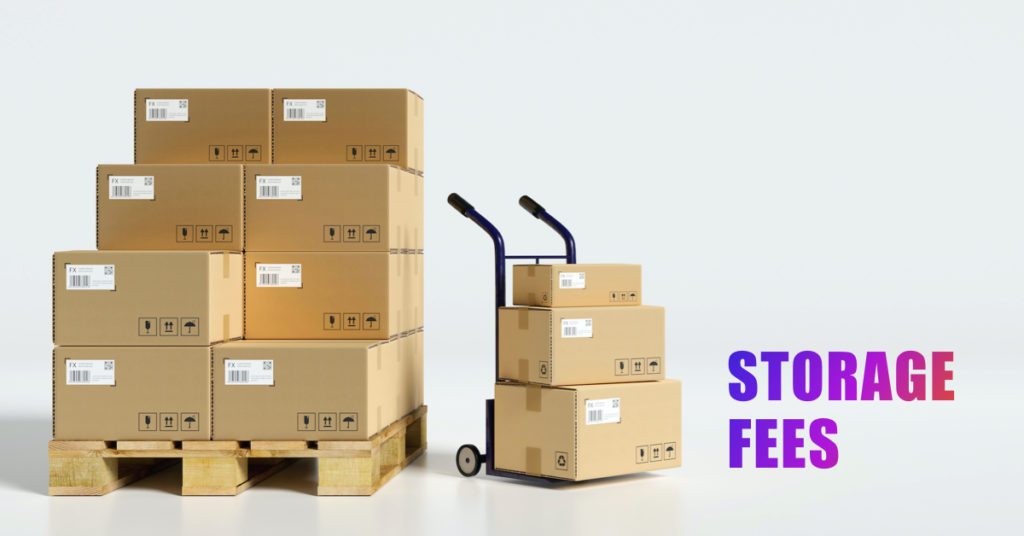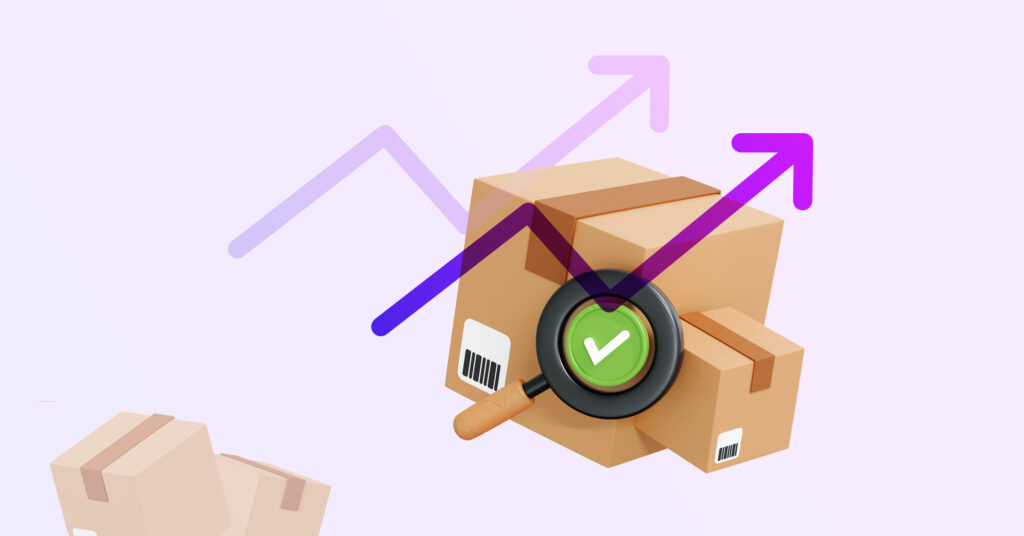Learn about the different Amazon fulfillment storage costs and how they are calculated
Originally published July 16, 2019; revised and updated October 7, 2021
Some things in life sound too good to be true. Like toilet seat warmers. Or pretzel-crust pizza.
Amazon’s FBA program is in that category.
With a catchy logo that boasts “Let Amazon pick, pack, and ship your orders”, sellers are encouraged to utilize Amazon’s advanced fulfillment networks through FBA.
Sellers using Amazon FBA (Fulfillment by Amazon) get perks such as eligibility for Amazon Prime, plus they don’t have to worry about storing inventory, handling picking, packing, and shipping, or even dealing with customer returns. Instead, Amazon stores its inventory in its fulfillment centers and handles all the shipping and returns tasks on the behalf of sellers.
While the (mostly) hands-off nature of Amazon FBA is appealing to many Amazon sellers, it does come at a price. One of the biggest fees sellers have to account for is Amazon storage cost. Here’s what you need to know about Amazon fba storage fees and how they’re calculated.
How to Calculate Amazon Inventory Volume
Have you ever heard of Amazon warehouse fees?
Depending on what you are selling, the fba inventory storage fees can take out a significant portion of your earnings. They are charged by the cubic foot, based on the daily average volume a seller’s inventory occupies in Amazon’s fulfillment centers.
The measurement is based on unit size when items are packaged in line with Amazon FBA policies and requirements and ready to ship. Learn more about listing, preparing, and shipping your FBA inventory to Amazon’s fulfillment centers here and specific packaging and preparation requirements here.
If you know your packaged units’ dimensions in inches, it’s easy to convert to cubic feet to estimate your storage fees:
- Multiply the item’s length x width x height
- Divide the total volume by 12 to convert to cubic feet
Using an Amazon FBA Calculator can help you calculate your total Amazon FBA fees, including amazon fulfillment fees.
How to Calculate Monthly Amazon Inventory Storage Fees
The Amazon monthly inventory storage fee is what sellers pay to Amazon in exchange for storing their inventory at Amazon’s fulfillment centers. These fees are based on two product size tiers – standard-size and oversize – and are charged between the 7th and 15th of the following month.
The monthly Amazon storage fee, charged by the cubic foot, varies based on the product size tier and the time of the year. Generally, storage fees are higher between October and December, during the busy holiday shopping season when fulfillment centers everywhere are at max capacity.
For standard-size products, monthly storage fees are:
- $0.75 per cubic foot between January and September
- $2.40 per cubic foot between October and December
For oversize products, monthly storage fees are:
- $0.48 per cubic foot between January and September
- $1.20 per cubic foot between October and December
If you’re wondering why the fba storage fees are notably lower for oversize products, Amazon has a good explanation: They require more complex bins, drawers, and shelving units that are more costly. However, given that oversize products are larger than standard-size products, and fees are charged by the cubic foot, monthly storage fees tend to be lower overall for standard-size products.
Amazon Monthly Storage Fees for Dangerous Goods
If you’re using FBA for inventory that Amazon deems as “dangerous goods,” you’ll pay a bit more in monthly storage fees. Basically, dangerous goods are items that require special handling and hazmat (hazardous materials) storage. To sell such items, sellers need to be in the FBA Dangerous Goods program.
Monthly storage fees for standard-size dangerous goods are:
- $0.99 per cubic foot between January and September
- $3.63 per cubic foot between October and December
For oversize dangerous goods, monthly storage fees are:
- $0.78 per cubic foot between January and September
- $2.43 per cubic foot between October and December
Long-Term Inventory Storage Fees
In addition to monthly inventory storage fees, Amazon FBA sellers may also have to pay long-term inventory storage fees for items stored in Amazon’s fulfillment centers longer than 365 days. Amazon conducts an inventory cleanup on the 15th of every month, at which time inventory that’s been in fulfillment centers for more than 365 days is charged a long-term storage fee of $6.90 per cubic foot or $0.15 per-unit – whichever is greater.
Avoiding Long-Term Inventory Storage Fees
Sellers can avoid fba long-term storage fees by keeping tabs on the length of time your inventory has been stored in fulfillment centers. Inventory Age and Inventory Health reports provide insights on the ASINs that have been in storage for:
- 0 to 90 days
- 91 to 180 days
- 181 to 270 days
- 271 to 365 days
- 365+ days
Using this data, it’s easy to estimate which ASINs will be subject to long-term storage fees by the 15th of the following month, when Amazon conducts its inventory cleanups. The Recommended Removals report calculates the number of items you’d need to remove, by ASIN, to avoid long-term storage fees if no additional items are sold.
Why does Amazon do this? Because they don’t want to be a warehouse. That’s not where they make the bulk of their money. So if you aren’t selling inventory, they are going to fine you for leaving your units in their fulfillment centers.
If you’re at risk of being charged long-term storage fees, you have a few choices:
- Submit a removal order by 11:59 p.m. (PT) on the 14th of the month to avoid having those items incur fees, even if they’re not physically removed by the next inventory cleanup. Removal order fees are charged only when the inventory is disposed of or returned to you.
- Set up automated removals, which allows you to automatically designate items for removal based on your automated long-term storage fee removal settings. You can either elect to have all items removed that will incur long-term storage fees or only items within a specified price range. You can opt to have items below a certain price removed while keeping higher-priced inventory as well, meaning you’d only pay the fees for the inventory you’re not removing. The removed inventory will either be disposed of or returned to you.
- Isolate the items that are at risk of incurring fees in a special ad campaign with the goal of liquidation. Advertise aggressively to get those products purchased and out of storage quickly. The goal of this campaign isn’t advertising efficiency that increases your profit. Instead, it’s selling through inventory quickly at an ad spend that is less than the long-term storage fees would be.
- Liquidate the items by marking them down at least 20% and offering them through Amazon Outlet.
Note that removing products can impact the amount of new inventory that you can send to Amazon under the FBA program. The number of new units you’re eligible to send is based on the number of sales in the preceding 90 days, projected sales for the next eight weeks, in-stock units, inventory utilization, and other factors.
Long-term storage fees will also impact your Inventory Performance Index (IPI) which will have implications for your ability to fully leverage FBA for storage and fulfillment.
Like any fulfillment center, Amazon incurs overhead costs for inventory stored in its facilities. Amazon FBA sellers are charged fees based on the volume of inventory stored in Amazon’s fulfillment centers, with additional fees for items stored for more than one year. For many FBA sellers, these fees are a worthwhile tradeoff compared to the costs (and hassle) associated with maintaining their own warehouses and fulfillment centers.
Conclusion
Utilizing Amazon’s FBA program is undoubtedly a good idea. In other words, the pros outweigh the cons.
However, we strongly encourage sellers to also utilize FBM (fulfilled by merchants) as a backup. This allows you to move products in and out of Amazon’s fulfillment center with lower costs and penalties. It also is a good idea for emergencies like when COVID first hit and all of Amazon’s centers were overstocked.
Having a second warehouse will benefit you in the long run and allow you to maintain a good IPI score.




